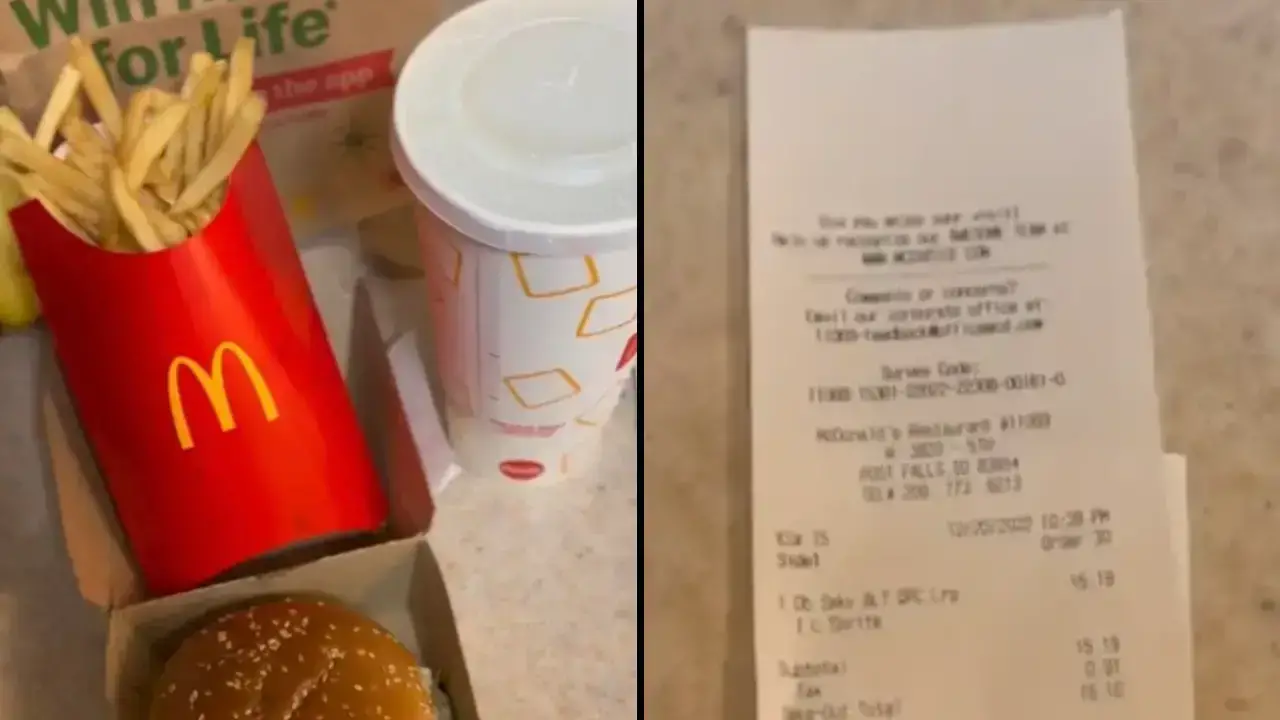McDonald’s Under Fire as Rising Costs Spark Affordability Concerns Among Customers
Amid an escalating cost-of-living crisis, one McDonald’s customer has ignited debate over the fast food chain’s pricing by sharing a receipt for a seemingly ordinary meal. The digital disclosure, posted on TikTok, has resonated with thousands of viewers, many of whom feel that McDonald’s is no longer offering the affordability it once promised.
The Receipt That Sparked the Conversation
Christopher Olive, a content creator with a substantial following on TikTok, recently posted a video revealing his latest McDonald’s bill. His order—a Smoky Double Quarter Pounder BLT burger, a large serving of fries, and a Sprite—totaled $16.10. Although this combination represents a fairly standard meal at McDonald’s, Olive’s reaction suggests that even this familiar order now seems disproportionately expensive in the current economic climate.
In his video, Olive acknowledged the broader challenges that have led to rising prices across various sectors. “I get that there’s a labor shortage and wage increases, and there are a number of other factors at play,” he explained. “But sixteen dollars for a burger, large fries, and a drink? It’s just crazy.” His candid commentary quickly struck a chord with viewers who are facing similar financial pressures.
Economic Pressures and Consumer Sentiment
The increasing cost of energy, housing, and basic necessities has left many consumers re-evaluating their spending habits. With energy and housing prices soaring to unprecedented levels, everyday expenses such as food have also seen significant price hikes. For many, the notion of affordable fast food is becoming a relic of the past. This sentiment is clearly reflected in the flood of comments on Olive’s TikTok post.
Many viewers questioned the justification behind McDonald’s current pricing. One commenter remarked, “Five Guys prices at McDonald’s?!” while another noted, “At that price, it might as well be a sit-down restaurant.” Such reactions underscore a growing frustration among consumers, who feel that fast food should remain an accessible and convenient option even amid economic challenges.
Diverging Opinions: A Debate on Value
While a significant number of viewers supported Olive’s concerns, not all agreed that the pricing was inherently unreasonable. Some users pointed out that Olive’s order included some of the more expensive items on the menu, suggesting that his reaction might be influenced by his specific choice of meal. One TikTok viewer commented, “Bro ordered the most expensive meal they have and acted surprised,” and another added, “You got the most expensive thing on their menu.” These responses highlight the ongoing debate about whether McDonald’s pricing is truly indicative of an industry-wide affordability crisis or if it is simply a matter of consumer expectations being challenged by premium menu selections.
Despite these differing viewpoints, the broader narrative remains clear: consumers are increasingly aware of—and sensitive to—the cumulative impact of rising prices. The fact that a routine meal at one of the world’s largest fast food chains is drawing such attention signals a significant shift in public sentiment.
McDonald’s Response and Strategic Reassessment
The mounting customer dissatisfaction comes at a time when McDonald’s is already facing pressures to re-examine its pricing strategies. According to a 2024 report by the BBC, the fast food giant has begun reconsidering its pricing model following a noticeable decline in sales. Outlets open for at least a year experienced a 1% fall in sales during the April-June period—the first such decline since the onset of the COVID-19 pandemic.
Chris Kempczinski, McDonald’s CEO, has reportedly acknowledged the need for change in light of these developments. Sources suggest that the company is undertaking a “comprehensive rethink” of its pricing strategy, aiming to balance operational costs with consumer expectations. The reassessment comes amid a broader context of economic uncertainty, where customers are becoming increasingly discerning about how they spend their money.
The Broader Context of a Cost-of-Living Crisis
The conversation about McDonald’s affordability is part of a larger discussion about the rising cost of living, which has affected multiple facets of daily life. As energy and housing prices soar, consumers are forced to allocate more of their budgets to these essentials, leaving less disposable income for other expenses—including dining out. In this economic climate, even traditionally budget-friendly options like fast food are coming under scrutiny.
Food costs have risen across the board, and many families are now making more deliberate choices about where and what they eat. For some, the decision to dine at fast food restaurants is no longer based solely on convenience or affordability but on a careful evaluation of overall value. The growing number of voices criticizing McDonald’s prices is indicative of a broader shift in consumer behavior—one that emphasizes financial prudence in the face of systemic economic challenges.
The Role of Social Media in Amplifying Consumer Voices
Social media platforms, particularly TikTok, have played a crucial role in bringing these concerns to the forefront. Videos like Christopher Olive’s have become a catalyst for discussion, enabling everyday consumers to share their experiences and opinions on issues that affect their daily lives. The viral nature of such content underscores the power of digital platforms to influence public discourse and drive corporate accountability.
In the case of McDonald’s, Olive’s post not only captured the immediate reaction of frustrated customers but also contributed to a larger conversation about the sustainability of current pricing models in a rapidly changing economic environment. Social media, with its capacity for rapid information dissemination, is increasingly becoming a forum where consumers can voice their dissatisfaction and demand change from major corporations.
Implications for the Future of Fast Food
The growing debate over McDonald’s pricing is likely to have significant implications for the fast food industry as a whole. As consumers become more price-sensitive, fast food chains may need to adjust their menus, portion sizes, or pricing strategies to remain competitive. The challenge for these companies will be to strike a balance between maintaining profitability amid rising operational costs and ensuring that their offerings remain accessible to a broad customer base.

For McDonald’s, a comprehensive review of its pricing strategy could involve exploring various avenues for cost reduction, including supply chain optimization, enhanced operational efficiencies, and the strategic introduction of lower-priced menu options. At the same time, the company will need to address the expectations of a diverse customer base, ranging from loyal patrons accustomed to affordable meals to those who may be drawn to premium offerings.
Conclusion: Navigating an Era of Economic Uncertainty
The recent outcry over McDonald’s pricing, as highlighted by Christopher Olive’s viral TikTok post, is emblematic of the challenges that both consumers and corporations face in today’s economic environment. As the cost of living continues to rise, every expense—from energy bills to fast food—comes under increased scrutiny. For many consumers, the notion that a staple of affordable dining has become a financial burden is both surprising and concerning.
McDonald’s, as one of the world’s most recognized fast food brands, now finds itself at a crossroads. The company’s forthcoming reassessment of its pricing strategy will be critical in determining its ability to meet evolving consumer expectations while managing the pressures of a shifting economic landscape. The discussion sparked by Olive’s post serves as a reminder that in today’s digital age, consumer voices are more powerful than ever. Through platforms like TikTok, everyday individuals have the ability to influence corporate policies and drive meaningful change.
As the fast food industry grapples with these challenges, the situation at McDonald’s may well serve as a bellwether for broader trends in consumer spending and corporate strategy. In an era marked by economic uncertainty, the importance of maintaining affordability and value has never been more apparent. For both consumers and businesses, navigating this landscape will require flexibility, innovation, and a keen understanding of the evolving dynamics of modern commerce.

Lila Hart is a dedicated Digital Archivist and Research Specialist with a keen eye for preserving and curating meaningful content. At TheArchivists, she specializes in organizing and managing digital archives, ensuring that valuable stories and historical moments are accessible for generations to come.
Lila earned her degree in History and Archival Studies from the University of Edinburgh, where she cultivated her passion for documenting the past and preserving cultural heritage. Her expertise lies in combining traditional archival techniques with modern digital tools, allowing her to create comprehensive and engaging collections that resonate with audiences worldwide.
At TheArchivists, Lila is known for her meticulous attention to detail and her ability to uncover hidden gems within extensive archives. Her work is praised for its depth, authenticity, and contribution to the preservation of knowledge in the digital age.
Driven by a commitment to preserving stories that matter, Lila is passionate about exploring the intersection of history and technology. Her goal is to ensure that every piece of content she handles reflects the richness of human experiences and remains a source of inspiration for years to come.
